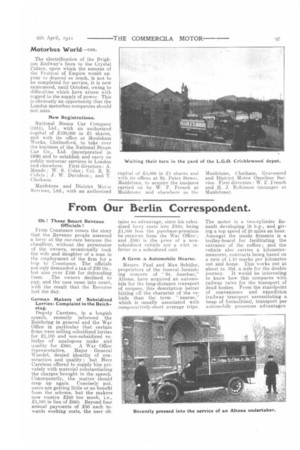From Our Berlin Correspondent.
Page 9

If you've noticed an error in this article please click here to report it so we can fix it.
Oh Those Smart Revenue Officials From Constance comes the story that the Revenue people assessed a lorry at the car-rate because the chauffeur, without the permission of the owners, occasionally took the wife and daughter of a man in the employment of the firm for a trip to Constance. The officials not only demanded a tax of £20 10s., but also over £100 for defrauding them. The owners declined to pay, and the case came into court, with the result that the Revenue lost the day.
German Makers of Subsidized Lorries: Complaint in the Reichstag.
Deputy Carstens, in a longish speech, recently informed the Reichstag in general and the War Office in particular that certain firms were selling subsidized lorries for £1,100 and non-subsidized vehicles of analogous make and quality for £850. A War Office representative, Major General Wandel, denied identity of construction and quality ; but Herr Carstens offered to supply him privately with material substantiating the charges brought in the speech. Consequently, the matter should crop up again. Concisely put, users are getting little or no benefit from the scheme, but the makers now receive £250 too much, i.e., g1,100 in lieu of £850. Beyond four annual payments of 250 each towards working costs, the user ob tains no advantage, since his subsidized lorry costs him £850, being £1,100 less the purchase-premium he receives from the War Office ; and 1850 is the price of a nonsubsidized vehicle not a whit inferior to a subsidized unit.
A Germ At Automobile Hearse.
Messrs. Paul and Max Schiller, proprietors of the funeral furnishing concern of " St. Anschar," Altona, have acquired an automobile for the long-distance transport of corpses, this description better hitting off the character of the vehicle than the term "hearse," which is usually associated with comparatively-short average trips.
The motor is a two-cylinder Renault developing 16 h.p., and giving a top speed of 28 miles an hour. Amongst the inside fitments is a trolley-board for facilitating the entrance of the coffins ; and the vehicle also carries a kilometremeasurer, contracts being based on a rate of 1.10 marks per kilometre out and home. This works out at about is. 10d. a mile for the double journey. It would be interesting to know how this compares with railway rates for the transport of dead bodies. From the standpoint of convenience and expedition (railway transport necessitating a heap of formalities), transport per automobile possesses advantages




















